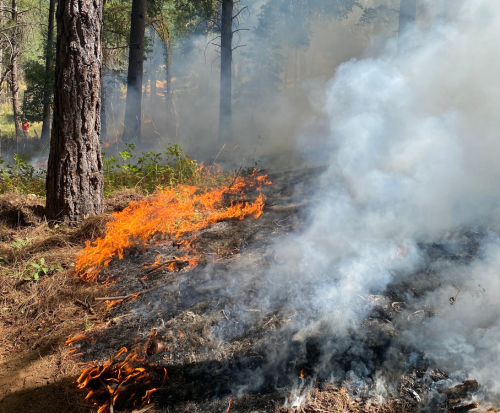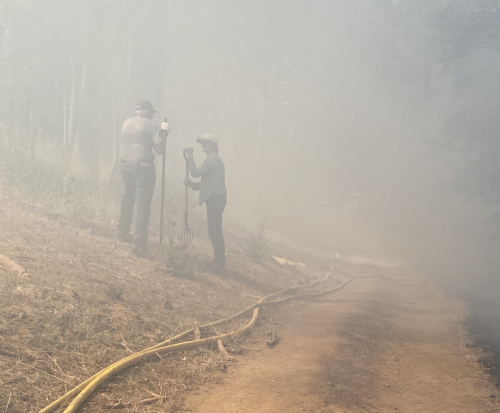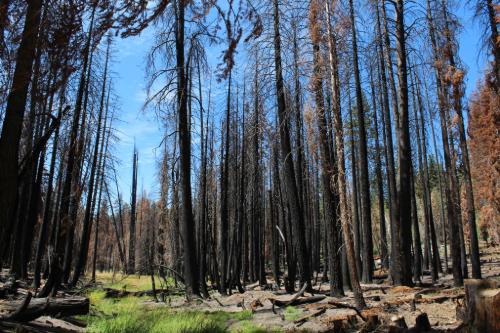Wildland fire
Overview
Wildfires are a common occurrence in California and are particularly concerning for those in the Wildland-Urban Interface (WUI), or areas where homes are built near natural vegetation. Small acreage landowners often buy property in the WUI and need to be prepared to deal with fires. The UC ANR Fire Network has ample resources about understanding, preparing for, using, responding to, and recovering from fire. We briefly summarize some of the main takeaways from that website here, as applied to small acreage landowners in California, and link to pages from the UC ANR Fire Network when appropriate.

Figure 1: A low-intensity prescribed fire in a conifer-dominated forest in the WUI. Photo/courtesy Dan Macon.
Prepare
Having emergency contact numbers ready and accessible will reduce stress in an emergency. You should compile the numbers of your:
- County Office of Emergency Services
- County Animal Shelters
- County Agricultural Commissioner
- Local Animal Services
- Veterinarian
- Other personal emergency contacts
Here is a downloadable form - EmergencyContactNumbers - where you can compile your emergency contact numbers and print them. Additionally, know how to access verifiable emergency alerts and updates from your local Fire Department and Sheriff’s Office.
An emergency preparedness kit is also crucial to have prepared before a wildfire starts. The UC ANR Fire Network provides a checklist for what to pack in an emergency go-bag. Additional information can be accessed from CAL FIRE’s website as well. Common items for a human and livestock emergency kit include: a list of emergency contact numbers, three-day supply of nonperishable human food, three gallons of water per person, any prescriptions, change of clothing, copies of important documents (passport, birth certificate, etc.), extra cash, extra eyeglasses/contacts, phone charger/power bank, flashlights, utility tool, first aid items, portable radio, extra batteries, shovel, wire cutters, bleach, tarps, portable generator, animal ropes and halters, water buckets, and extra animal feed.
Creating an evacuation plan will allow you to act confidently in the event of a wildfire, with less chance of confusion and harm. The UC ANR Fire Network provides a household pre-evacuation checklist that you can print and use for various evacuation order statuses. Additional information can be found from CalFire’s wildfire preparedness plan. You can also read this blog post from UC ANR Livestock and Natural Resources advisor Dan Macon about preparing a livestock operation for fire. Some questions to ask yourself, if you have livestock: How will you get your livestock off the property? If necessary, does someone you know have a trailer you can use? Where is your local evacuation center? If you can’t evacuate livestock, are you prepared to open internal gates or take down temporary fences and leave enough feed and water for a few days?
Prevent
Reduce fuel loads: Preventing damaging fires is a landscape level effort. To do your part on your property, you can manage fuel loads by creating fuel breaks and by using burn piles or prescribed fire or chipping, grazing, spraying, or hauling excess vegetation. You can learn more on the UC ANR Fire Network Reducing Forest Fuels page.
Defensible space: It is also important to create defensible space around structures like homes and shops/sheds. There are 3 zones of defensible space around structures as described on the UC ANR Defensible Space for Farms and Ranches page. Briefly, within the first 5 feet of a structure (Zone Zero), there should be no combustible material and you can use rocks or gravel to prevent any vegetation growth. Between 5 and 30 feet from a structure (Zone One), grasses should be mowed or grazed to a maximum height of 4 inches, dead vegetation should be removed, and trees and shrubs should be thinned and pruned. Between 30 and 100 feet from a structure (Zone Two), vegetation is modified as in Zone One and aboveground fuel tanks and large equipment should be on a noncombustible surface (pad, bare ground, gravel, concrete) and be spaced 20 feet apart.
Landscaping choices: Many landowners want to landscape their property and plant species selection is a common question. It is important to select plant species and varieties that are not invasive which will aggressively dominate other vegetation and can change the ecological function of the land. When preparing for wildland fire, it is also important to choose plant species that do not combust readily and do not contain highly flammable components. However, all plants will burn, and growing conditions and maintenance can have a greater impact on flammability than the species itself. You can learn more about fire-resilient plant maintenance by checking out the UC ANR Fire Network fire resilient plant page.
Respond
During a wildfire, you will need to respond to the conditions as they develop. Check the CAL FIRE Incident Information Page, your local Office of Emergency Services or sheriff’s department websites, and local news stations for the most up-to-date information on wildfires in your area.
Make sure to listen to local weather conditions (battery-powered radios can be dependable in large power outages) and heed any evacuation orders. Working together as a community to respond appropriately and collaboratively to any disaster will improve the outcomes for you and your community as a whole. If you can, check in on those who are vulnerable in your community during a wildfire. This may include those who are not as well connected as you, the elderly, the disabled, non-driving people, and any marginalized population.
The Governor’s Office of Emergency Services (CalOES) is the lead agency for animal evacuations during natural disasters. Additionally, the California Veterinary Emergency Team, administered by the UC Davis School of Veterinary Medicine, mobilizes in response to disasters anywhere in California. The service is used when local veterinary capacity has been overwhelmed and state assistance is needed. Here is a link to the CVET Resource Guide, which includes their hotline contact information.
You can read the UC ANR Fire Network what to do when trapped page to learn survival lessons if you are ever trapped in a fire. Remember, these strategies will help keep you safe if you are trapped in a fire, but preparing ahead of time and evacuating early is the best way to stay safe and avoid being harmed by fire.

Figure 2: Smokey conditions generated by a prescribed fire. Photo/courtesy Dan Macon.
Recover
After a wildfire, it may take some time for you to recover from the physical impacts to your property and the psychological impacts of going through a wildfire. It is normal to struggle to adjust to the change that comes with any disaster. If you need help, you can call or text the American Red Cross Disaster Distress Helpline at 1-800-985-5990. You can read the American Red Cross page called Recovering Emotionally from a Disaster and the UC ANR Fire Network page on Mental Health after a fire.
When you first assess your property post-fire, survey any livestock that were left behind, look at feed and forage that remain. After a fire that creates bare soil in large areas, you may need to reassess how much forage is available for your livestock; this 2011 UC ANR publication helps you calculate the cost of forage losses and this 2023 UC ANR publication provides some postfire grazing guidelines. You can also read some considerations about grazing after fire and post-fire management on the UC ANR Fire Network page.
Water sources like surface or ground water may be contaminated by fires, so you can send in drinking water to be tested. The California Animal Health and Food Safety Lab system (CAHFS) is one lab that can do water testing.

Figure 3: Conifer forest post- high severity wildfire. Following high severity wildfire, standing dead trees may need to be felled to maintain safety near roads and structures. Photo/courtesy Julie Finzel.
Resources
The UC ANR Fire Network has a plethora of information that you can explore on their website. The Fire Network recently developed three factsheets that could be insightful for small acreage landowners:
- Land Stewardship and Vegetation Management
- Keeping Livestock Safe and Healthy During Wildfire
- Wildfire Preparedness for Farms, Ranches, and Agricultural Operations
The UC ANR Fire network also has two evacuation resources that will help you prepare for wildfires:
You can also check out the CAL FIRE Ready for Wildfire website.
Tahoe Living with Fire has created a Wildfire Home Retrofit Guide.
A Home Landscaping Guide for Lake Tahoe and Vicinity offers important water quality and home-hardening tips widely applicable across California and includes a planting list.